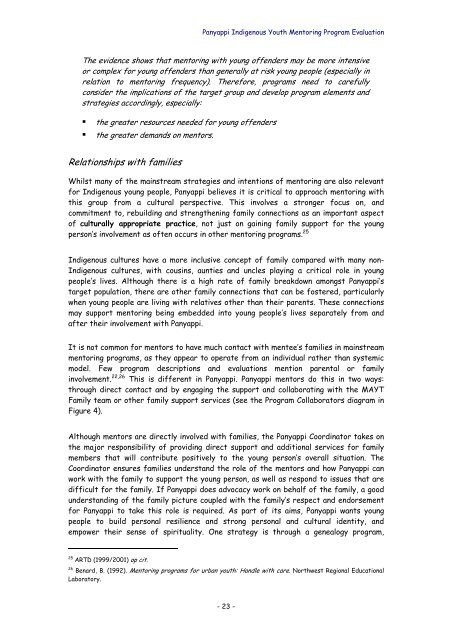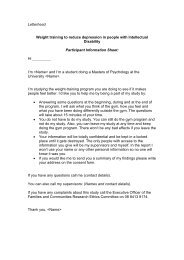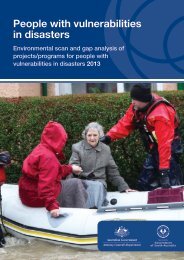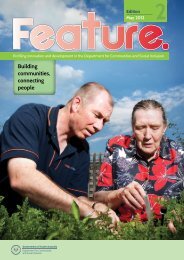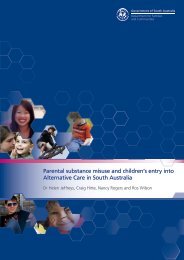Panyappi Indigenous Youth Mentoring Program Evaluation
Panyappi Indigenous Youth Mentoring Program Evaluation
Panyappi Indigenous Youth Mentoring Program Evaluation
Create successful ePaper yourself
Turn your PDF publications into a flip-book with our unique Google optimized e-Paper software.
<strong>Panyappi</strong> <strong>Indigenous</strong> <strong>Youth</strong> <strong>Mentoring</strong> <strong>Program</strong> <strong>Evaluation</strong><br />
The evidence shows that mentoring with young offenders may be more intensive<br />
or complex for young offenders than generally at risk young people (especially in<br />
relation to mentoring frequency). Therefore, programs need to carefully<br />
consider the implications of the target group and develop program elements and<br />
strategies accordingly, especially:<br />
�<br />
�<br />
the greater resources needed for young offenders<br />
the greater demands on mentors.<br />
Relationships with families<br />
Whilst many of the mainstream strategies and intentions of mentoring are also relevant<br />
for <strong>Indigenous</strong> young people, <strong>Panyappi</strong> believes it is critical to approach mentoring with<br />
this group from a cultural perspective. This involves a stronger focus on, and<br />
commitment to, rebuilding and strengthening family connections as an important aspect<br />
of culturally appropriate practice, not just on gaining family support for the young<br />
person’s involvement as often occurs in other mentoring programs. 25<br />
<strong>Indigenous</strong> cultures have a more inclusive concept of family compared with many non-<br />
<strong>Indigenous</strong> cultures, with cousins, aunties and uncles playing a critical role in young<br />
people’s lives. Although there is a high rate of family breakdown amongst <strong>Panyappi</strong>’s<br />
target population, there are other family connections that can be fostered, particularly<br />
when young people are living with relatives other than their parents. These connections<br />
may support mentoring being embedded into young people’s lives separately from and<br />
after their involvement with <strong>Panyappi</strong>.<br />
It is not common for mentors to have much contact with mentee’s families in mainstream<br />
mentoring programs, as they appear to operate from an individual rather than systemic<br />
model. Few program descriptions and evaluations mention parental or family<br />
involvement. 22,26 This is different in <strong>Panyappi</strong>. <strong>Panyappi</strong> mentors do this in two ways:<br />
through direct contact and by engaging the support and collaborating with the MAYT<br />
Family team or other family support services (see the <strong>Program</strong> Collaborators diagram in<br />
Figure 4).<br />
Although mentors are directly involved with families, the <strong>Panyappi</strong> Coordinator takes on<br />
the major responsibility of providing direct support and additional services for family<br />
members that will contribute positively to the young person’s overall situation. The<br />
Coordinator ensures families understand the role of the mentors and how <strong>Panyappi</strong> can<br />
work with the family to support the young person, as well as respond to issues that are<br />
difficult for the family. If <strong>Panyappi</strong> does advocacy work on behalf of the family, a good<br />
understanding of the family picture coupled with the family’s respect and endorsement<br />
for <strong>Panyappi</strong> to take this role is required. As part of its aims, <strong>Panyappi</strong> wants young<br />
people to build personal resilience and strong personal and cultural identity, and<br />
empower their sense of spirituality. One strategy is through a genealogy program,<br />
25 ARTD (1999/2001) op cit.<br />
26 Benard, B. (1992). <strong>Mentoring</strong> programs for urban youth: Handle with care. Northwest Regional Educational<br />
Laboratory.<br />
- 23 -


